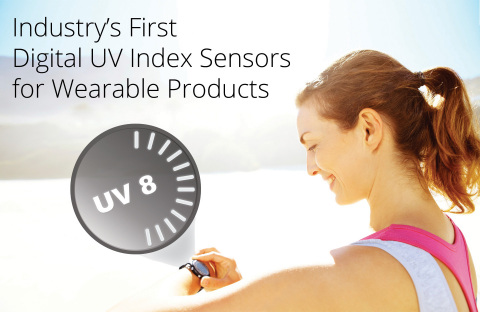Single-Chip Si1132/4x Optical Sensors Track UV Exposure, Ambient Light and Biometrics for Smartphones and Wearable Computing Products
AUSTIN, Texas — (BUSINESS WIRE) — February 10, 2014 — Silicon Labs (NASDAQ: SLAB), a leader in high-performance, analog-intensive, mixed-signal ICs, today introduced the industry’s first single-chip digital ultraviolet (UV) index sensor ICs designed to track UV sun exposure, heart/pulse rate and blood oximetry and provide proximity/gesture control for smartphone and wearable computing products. The latest additions to Silicon Labs’ optical sensor family, the Si1132 and Si114x sensor ICs are ideal for activity-tracking wrist and arm bands, smart watches and smartphone handsets. In addition to enabling UV index sensing, the devices also provide ambient light and infrared (IR) proximity sensing capabilities for health and fitness applications.

Industry's first single-chip digital UV index sensor solution for wearable computing products (Photo: Business Wire)
The demand for UV sensing in consumer electronics is rising as developers seek to differentiate wearable and handset products with new features that help protect people from harmful UV light exposure. UV tracking is helpful for those with elevated risks of sunburn or concerns about excessive sun exposure. UV sensor-equipped products can measure cumulative UV exposure and alert end users before they have reached unhealthy exposure levels while exercising outdoors. Standardized by the World Health Organization (WHO), the digital UV index is linearly related to the intensity of sunlight and is weighted according to the Erythemal Action Spectrum developed by the International Commission on Illumination (CIE). This weighting provides a standardized measure of our skin’s response to different sunlight wavelengths including UVB and UVA.
Conventional UV sensors combine UV-sensitive photodiodes with an external microcontroller (MCU), analog-to-digital converter (ADC) and signal processing firmware. Silicon Labs is the first to combine all of this functionality into a single-chip solution offered in an exceptionally small 2 mm x 2 mm package that helps reduce the design’s footprint and bill of material (BOM) cost. The UV sensor family includes the following devices:
- Si1132 UV index and ambient light sensor with an industry-standard I2C interface to read digital UV index values
- Si1145/46/47 UV and IR proximity/ambient light sensors offering a choice of one, two or three integrated LED drivers with 15 selectable drive levels for gesture detection.
When combined with an accelerometer, the Si1132 and Si114x sensors enable developers to implement sleep tracking in wearable applications. In addition, the sensors’ ability to measure both infrared and visible light levels enhances the control of LCD backlighting in mixed light source environments. The result is an inexpensive yet effective means of adjusting backlighting to ease eyestrain and reduce power without distracting the end user.
The Si114x sensors’ LED drivers enable implementation of reflective heart rate and blood oximetry measurement capabilities for health and fitness trackers, as well as touchless interfaces that support end-user control from a distance. Offering two and three infrared LED drivers respectively, the Si1146 and Si1147 sensors enable advanced motion and gesture sensing. The Si1146 enables motion sensing and touchless control in the z- and x-axis, and the Si1147 adds a third axis to enable 3-dimensional motion sensing. Both sensors provide reflectance measurements that can be post-processed to determine gestures.
The Si1132 and Si114x sensors offer excellent performance under a wide dynamic range of light sources including direct sunlight. The robust sensing architecture also includes an ambient light sensor capable of sensing light levels up to 128 kLux. The photodiode response and associated digital conversion circuitry provide excellent immunity to artificial light flicker noise and natural light flutter noise.
The UV index sensors’ ultra-low-power architecture enables thinner wearable designs with smaller batteries and extends battery life with as little as 1.2 µA average current for once-per-second UV measurements. The sensors also offer greater sensitivity and sensing range at significantly lower power levels than competitive offerings. The high IR sensor sensitivity provides significantly longer battery life in motion sensing/gesture applications through the use of a single 25.6 µs IR-LED on-time while enabling up to 50 cm sensing range. Dynamic adjustment of LED currents further minimizes power consumption.
“Wearable designs require highly integrated, small-footprint and low-power sensing solutions, and we’re meeting this need with the industry’s first single-chip digital UV index sensors that also provide ambient light and IR sensing capabilities for innovative health and fitness applications,” said Mark Thompson, vice president and general manager of Silicon Labs’ Access, Power and Sensor products. “Silicon Labs is the only UV index sensor vendor that offers a broad portfolio of energy-friendly MCUs, wireless MCUs and transceivers, and an array of other sensors that can be combined into system solutions for the fast-growing wearables market.”
Silicon Labs provides wearable developers with comprehensive hardware
and software tools to simplify testing, characterization, prototyping
and software development. The UVIrSlider2EK UV/IR evaluation kit
provides an advanced development platform for Silicon Labs’ optical
sensors. Controlled by an ultra-low-power C8051F800 MCU, the
UVIrSlider2EK connects the Si1146 sensor to two IR-LEDs, enabling UV
index measurements, advanced 2D/2-axis touchless gesture detection and
object proximity detection. The IrSlider2EK is pre-configured with
firmware that displays the five-level consumer UV strength index on five
LEDs. Demo software provides a GUI with the full UV index and an IR
slider demo that demonstrates left/right/pause gesture detection using
eight visible LEDs. In addition, Silicon Labs provides example software
source code for ambient light, proximity and gesture detection
algorithms.








